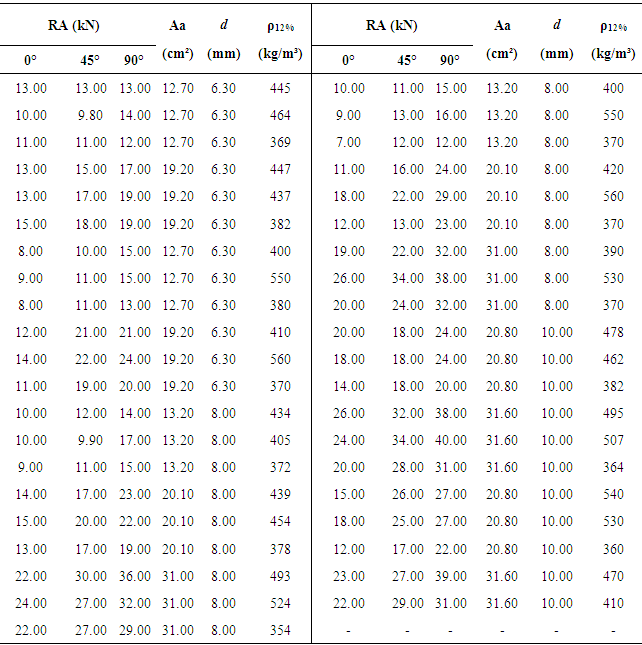-
Paper Information
- Paper Submission
-
Journal Information
- About This Journal
- Editorial Board
- Current Issue
- Archive
- Author Guidelines
- Contact Us
International Journal of Materials Engineering
p-ISSN: 2166-5389 e-ISSN: 2166-5400
2018; 8(5): 85-89
doi:10.5923/j.ijme.20180805.01

Pull Out Strength Evaluation of Bonded-in Steel Bars in Pinus oocarpa Shiede Structural Members
Júlio C. Pigozzo1, Felipe N. Arroyo2, Diego H. Almeida3, Anderson R. Vobornik Wolenski4, André L. Christoforo3, Francisco A. R. Lahr5
1Department of Civil Engineering, Technology Center, State University of Maringá (UEM), Maringá, Brazil
2Faculdades Integradas de Cacoal (UNESC), Cacoal, Brazil
3Department of Civil Engineering (DECiv), Federal University of São Carlos (UFSCar), São Carlos, Brazil
4Federal Institute of Santa Catarina - São Carlos Campus, São Carlos, Brazil
5Department of Structural Engineering (SET), São Carlos Engineering School, São Paulo University (EESC/USP), São Carlos, Brazil
Correspondence to: André L. Christoforo, Department of Civil Engineering (DECiv), Federal University of São Carlos (UFSCar), São Carlos, Brazil.
| Email: |  |
Copyright © 2018 The Author(s). Published by Scientific & Academic Publishing.
This work is licensed under the Creative Commons Attribution International License (CC BY).
http://creativecommons.org/licenses/by/4.0/

The connections with bonded-in steel bars present excellent aesthetics, trustworthy performance, high strength and stiffness, and are more economic compared to the equivalent traditional mechanical connections. Nonetheless, their use in an economic and safe way depends on the deeply knowledge about influences on the pull out behaviour and on many different connection work conditions. Among these parameters, it can be pointed out with great relevance, the diameter variation of the bars used, which influence directly on the adherence surface on the anchorage area. In this work, the experiment was conducted in order to evaluate the effects of steel bar diameter variations of bonded-in with the epoxy resin Compound, in three directions (0, 45and 90º) between the rods and the wood fibers. The wood natural variability was considered through random sample of a batch of structural Pinus oocarpa Shiedetimbers. In each observation, with a total of seven combinations of variables, six replications were presented. The steel bars used were highly stiffness ones (CA-50), with threaded surface solicited into the axial direction under monotonic loadings, with two consecutive load cycles. Thereafter statistical analysis, the results are presented and commented in a comparative way.
Keywords: Structural resins, Glued-in rods, Anchorage strength, Epoxi resin
Cite this paper: Júlio C. Pigozzo, Felipe N. Arroyo, Diego H. Almeida, Anderson R. Vobornik Wolenski, André L. Christoforo, Francisco A. R. Lahr, Pull Out Strength Evaluation of Bonded-in Steel Bars in Pinus oocarpa Shiede Structural Members, International Journal of Materials Engineering , Vol. 8 No. 5, 2018, pp. 85-89. doi: 10.5923/j.ijme.20180805.01.
Article Outline
1. Introduction
- The connection design is the key to ensuring the performance and safety of timber structures [1]. With the possibility of developing simple and durable connections, steel bars bonded with structural resins have been applied in different situations [2].This type of connection has received attention and recognition mainly for its excellent aesthetic appearance and performance. The connections with glued steel bars have been widely used in European countries, with the largest applications in glued laminated structures [3].Structural synthetic resins most used in timber structures are classified into three groups: phenol-resorcinol formoldehydes (PRF), polyurethanes (PUR) and epoxies (EP), which has been continuously developing and presenting better properties [4].Gardner [5] concluded that epoxy resins are clearly the most suitable adhesives for reinforcing or bonding steel elements in structural members. It is considered a new technology, with limitations of data on the behavior of these resins in long-term tests and there are many types of epoxy resins. The results obtained for one resin cannot be extrapolated, predicting the behavior of another.According to Bainbridge and Mettem [6], it is considered that the requirements for adhesives in this case are: to achieve good adhesion in wood; achieve significant shear strength (to keep the section of the adhesive layer intact); and to keep the anchoring of the bars (through the combination of chemical adhesion and mechanical adhesion), completely involving the bar rough surface. Due to the particularities of the bar surface preparation in the construction environment, the practice of using textured or filament bars has been standardized to maximize mechanical adhesion. Due to economic reasons, construction processes and the low cost of the material, it is possible to disregard the high levels of preparation of the bar surfaces to maximize the chemical adhesion, compared to the high performance of the mechanical adhesion.Several calculation models are developed to estimate the average response of the anchorage strength, with many independent variables involved, such as: natural variability of the wood mechanical properties; epoxy resin used; distance from the hole to the edge of the member; form of solicitation of the steel bar (one or two sides request); glue line thickness; bar surface roughness; predominant rupture model; anchorage length; bar diameter; moisture content of wood. Some of these variables can be controlled in the project, others are insignificant in the response and can be disregarded, leaving only a few independent and significant variables, such as: variations of moisture content of wood; variations in anchorage length; and variations of the bar diameters [7].
2. Literature Review
- Considering the steel bars anchorages with the following conditions: the predominant rupture model is the rupture of the adhesion on the steel surface, where it breaks initially the chemical adhesion and after the mechanical adhesion; using an epoxy resin which exhibits glassy consistency after hardening (particularly low or medium viscosity resins); necessarily steel bars with rough surfaces; and the glue line thickness not be less than 1.0 mm, subject to the following conditions (Equation 1).
 | (1) |
 | (2) |
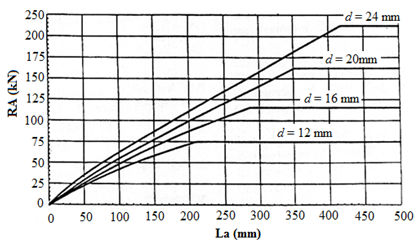 | Figure 1. Relationship between anchorage strength (RA) versus anchorage length (La) and steel bar diameter (d) [8] |
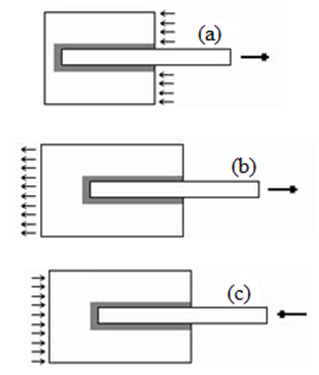 | Figure 2. Representation types of axial stresses in glued bars: (a) one-sided request; (b) and (c) two-sided requests [11] |
3. Material and Methods
- This experiment was carried out to evaluate the effects of the variations of the steel bar diameters on the anchorage strengths, using an epoxy resin (liquid consistency) in Pinus oocarpa Shiede wood specie (apparent density equal to 550 kg/m³). Anchorage strengths were compared with the same anchorage surface, however, varying steel bar diameters and anchorage length.Wood natural variability wood was considered by means of a random sampling, obtaining six timber beams with dimensions of 5.5x20x300 cm. From each beam a series of specimens were obtained, corresponding to the observations of desired anchorages. In this way, a total of six replications were carried out for each observation. The mechanical properties of the wood along the length of each studied beam were assumed constant.Specimens were manufactured considering the relationships between the effective anchorage surface and the nominal steel bar diameters, using the Equation 3, valid for the interval 6.3 mm ≤ d ≤ 12.5 mm [2].
 | (3) |
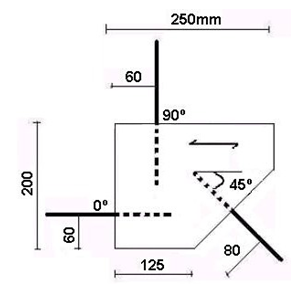 | Figure 3. Dimensions and positioning of the steel bars on the Pinus oocarpa Shiede specimen |
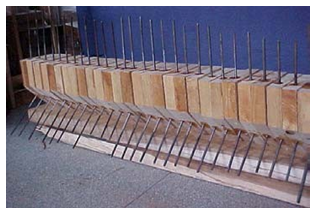 | Figure 4. Pinus oocarpa Shiede specimens with glued steel bar |
4. Results and Discussion
- Table 1 presents average anchorage strength results, according to three steel bar diameters (d1 = 6.3 mm; d2= 8 mm and d3 = 10 mm) for each direction to the grain (0, 45 and 90º).
|
|
 | Figure 5. Comparisons of anchorage strength for (a) anchorage surface and (b) apparent density variations in the 0, 45 and 90º directions |
5. Conclusions
- The results of this study permit us to conclude:- Anchorage strength at 90° directions are larger than the corresponding ones in the 45° direction, which in turn are larger than the corresponding ones in the 0° direction.- Regression models to estimate RA as function of Aa and ρ12% presented R² values higher to 90% for all directions between steel bar and wood specimen grain.
ACKNOWLEDGEMENTS
- For all the provided support, the authors thanks the Fundação de Amparo à Pesquisa do Estado de São Paulo (FAPESP) and Coordenação de Aperfeiçoamento de Pessoal de Nível Superior (CAPES).
 Abstract
Abstract Reference
Reference Full-Text PDF
Full-Text PDF Full-text HTML
Full-text HTML